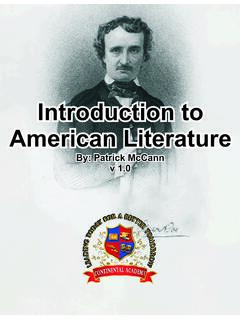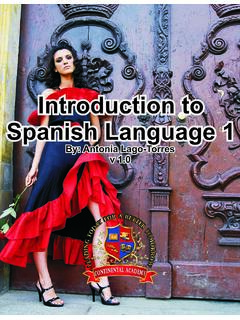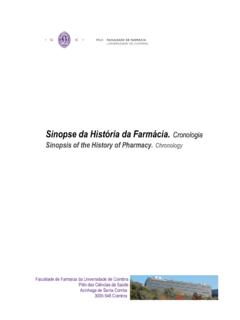Transcription of Learning Spanish Through Hispanic Culture 2
1 Learning SpanishThrough HispanicCulture 2 Learning SpanishThrough HispanicCulture 2By: Antonia Lago-Torresv : Antonia Lago-Torresv Spanish Through Hispanic Culture 2 INSTRUCTIONS Welcome to your Continental Academy courde Learning Spanish Through Hispanic Culture . It is madeup of 5 i ndividual lessons, as listed in the Table of Contents. Each lesson includes practice questions with answers. You will progress Through this course one lesson at a time, at your own pace. First, study the lesson thoroughly. Then, complete the lesson reviews at the end of the lesson and carefully check your answers. Sometimes, those answers will contain information that you will need on the gradedlesson assignments. When you are ready, complete the 12-20 question, multiple choice lesson assignment. At the end of each lesson, you will find notes to help you prepare for the online assignments. All lesson assignments are open-book. Continue work ing on the l essons at your own pace until you have finished all lesson assignments for this course.
2 When you have completd and passed all lesson a ssignments for this course, complete the End of Course Examination. If you need help understanding any part of the lesson, practice questions, or this procedure: Click on the Send a Message link on the left side of the home page Select Academic Guidance in the To field Type your question in the field provided Then, click on the Send button You will receive a response within ONE BUSINESS DAY Learning Spanish Through Hispanic Culture 3 About the Professor Antonia Lago-Torres earned her Masters degree in Public Administration at the University of Puerto Rico and her Bachelor of Arts in Bilingual Education at the World University of Puerto Rico. Professor Lago-Torres has ample experience in education (K-12) and at university level; curriculum development and assessment design; educational research and early childhood program evaluation. Professor Lago-Torres is also a book editor for children stories and textbooks for the elementary school level.
3 Learning Spanish Through Hispanic Culture ML 20 Editor: Antonia Lago-Torres Copyright 2008 Home School of America, Inc. ALL RIGHTS RESERVED The Continental Academy National Standard Curriculum Series Published by: Continental Academy 3241 Executive Way Miramar, FL, 33025 Learning Spanish Through Hispanic Culture 4 Applications of basic Spanish skills for advanced comprehension and communication are explored. Practical language usage techniques for new contexts are developed. Student will communicate in languages other than English Student will gain knowledge and understanding of other cultures Student will connect with other disciplines and acquire information Student will develop insight into the mature of language and Culture Student will participate in multilingual communities at home and around the world Learning Spanish Through Hispanic Culture 5 TABLE OF CONTENTS Page Introduction .. 6 Lesson 1 -- Meeting new 7 Lesson 2 -- More Adjectives.
4 27 Lesson 3-- The Adverbs ..55 Lesson 4 -- This is who we are! As Lesson 5 -- Diminutives and Augmentatives ..103 End of Course Learning Spanish Through Hispanic Culture 6 INTRODUCTION Spanish is a very old Language. It is originated from the Latin that is a Romance Language. For many years and during most of the middle Ages, Spain was influence by Rome, by its Language, Culture and customs. Latin was the Language spoken in Spain until Spanish was proclaimed the official Language of Castile; that is the reason that Spanish was first called Castilian or "Castellano". Spanish was also influenced by many other Languages including Arabic, Greek and Latin. When Spain discovered and settled America, many of the Languages spoken by the indigenous cultures like Aztecs, Mayas and Incas influenced Spanish . We see that influence in the names of people, places, foods, plants etc. Some times people think that there are many different kinds of Spanish ; but there are only differences in the use, the pronunciation and the intonation of certain words and sounds.
5 No matter what, there are always standard words that all Spanish speakers will understand. The Hispanic American Culture of today is inevitably moving in many directions, when people leave their country they leave with their heritage, their beliefs and their Language. You will be surprised to find out the rate in which the Hispanic Culture and the Spanish Language had spread around the modern world. That is why we invite you to learn it. The best and most effective way to learn a language is by using it and hearing it, not sporadically but constantly in a country of origin. This is not your situation, but we are going to try to transport you along with "the two amigos" to some Hispanic Countries; where we are going to explore and get submerged in real, authentic Spanish . Work diligently and enjoy not only the wonderful aspects of the language, but the soul and the history of the Hispanic people as well. Learning Spanish Through Hispanic Culture 7 Lesson 1: Let us meet our new friends When you go to a Spanish speaking country, and you will very soon, one of the first things you are going to do is to meet new friends.
6 To do this you will need to strike up a friendly conversation and use some of the handy expressions and conversation openers that we already learned. Do you remember the greetings Hola, Buenos d as, (tardes, noches) that we practiced? Now is time to use them. You are traveling to Spain; it is the first time that you are traveling to a Spanish speaking country. You arrived to Barajas airport in Madrid, the capital city, and you are looking for help to move around the luggage claim area and find yours. There you see the young boy that you saw in the plane and he greets you in Spanish . -Hola Buscando tus maletas? -Hola, I do not speak much Spanish . -I do speak some but with lots of effort. -Well, I came here to visit and learn the language, please talk to me in Spanish . -Bueno, Sabes a d nde vas o te vienen a recoger? -No, I came solo. I don't have an idea on what to do know. -It is my second time here and I have some ideas. Vienes conmigo? We can take a bus or a train to the city.
7 I am a student and came to spend my summer vacations and to learn more about my grandparent's country. I want to go to Learning Spanish Through Hispanic Culture 8 Pamplona for the Corridas de toros season also to enjoy some soccer games that I love. -That is very exciting and it's one of my dreams. I want to travel to different cities and learn about their Culture , traveling is the best education one can have. We need to find a hotel to stay and plan our trip to Pamplona. -Hotels are too expensive for students, here they have posadas at good prices and are fairly clean. Let us take the bus or the train to the city. By the way mi nombre es John Y el tuyo? -My name is Robert, but you may call me Roberto, like my Spanish teacher do. Now see if you can answer these questions: 1. What is a polite greeting in Spanish ? (a) adios (b) hola (c) est bien 2. When you travel, where do you pack your clothe in? (a) En una funda (b) en una maleta/bulto (c) en una caja 3.
8 How do you ask someone his name? (a) Qu pasa? (b) Como est s? (c) Cu l es tu nombre? 4. If someone asks your name how do you reply? (a) mi nombre (b) yo vivo (c) Son las siete Learning Spanish Through Hispanic Culture 95. Robert and John arrived at the airport (a) Madrid (b) Pamplona (c) New York 6. The two amigos wanted to go to Pamplona to see (a) Juego de pelota (b) carreras de auto (c) corridas de toros 7. They went to Spain to spend (a) Summer vacations (b) new life (c) a year 8. How are they going from the airport to the city? (a) by plane (b) by bus or train (c) by car 9. Where are they going to stay? (a) in a hotel (b) in a posada (c) with friends 10. John and Roberto (a) detectives (b) teachers (c) students Answer Key: 1(b) 2.(b) 3.(c) 4.(a) 5.(a) 6. (c) 7.(a) 8. (b) 9. (b) 10. (c) The two amigos got to la posada, and wanted to talk to the empleado in the check-in desk.
9 Roberto wanted to practice his Spanish and ask John to let him deal with the registration. -Buenas tardes, un cuarto con ba o para dos, por favor. - Buenas tardes Para cu ntas noche por favor? - No sabemos cu ntas, queremos ir a Pamplona. - Van a las corridas de toros? - S mi nuevo amigo y yo queremos ver los toros corriendo por la calle. - Es muy peligroso, m renlo desde un balc n a lo lejos. - S por supuesto, el cuarto con ba o para dos por favor. - Seguro Cu ntas noches? - Hasta que partamos para Pamplona. Learning Spanish Through Hispanic Culture 10 "El encierro" is celebrated in Pamplona up north Spain, every year from July 7th to the14th. Thousands pack into Pamplona to start Spain's most famous bull-running fiesta, to honors Navarra capital's patron saint, San Ferm n. Spain stages more than 3,000 fiestas (festivals) each year but the 7 days of bull-running are the favorite in terms of spectacle and excitement. After the daybreak of July 7th, runners (mainly young men) gather at the bottom of Santo Domingo, which is the starting line.
10 They crowd together and sing to the image of San Ferm n which is placed in a niche on a wall. The song goes: "A San Ferm n pedimos, por ser nuestro patr n, nos gu e en el encierro d ndonos su bendici n" ("We ask San Ferm n, as our Patron, to guide us Through the Bull Run and give us his blessing.") A rocket is then let off to make sure everyone knows the bulls are loose in the street. The bulls run along the narrow street 825 meters (half a mile) to a bull ring. The runners dash along in front of the bulls, aiming to feel the breath of the bull on their backs, getting as close as possible - all whilst trying to avoid getting gored by their sharp horns. Originally only a few daring souls ran with the bulls but the adrenaline rush of running in front of a 1500lb bull has since caught on. People now journey from all around the world to run with the bulls. Learning Spanish Through Hispanic Culture 11 Our two amigos are planning their trip to Pamplona. They asked for a road map and are marking the route they need to follow to get there on time for the "Grand Fiesta Brava".




